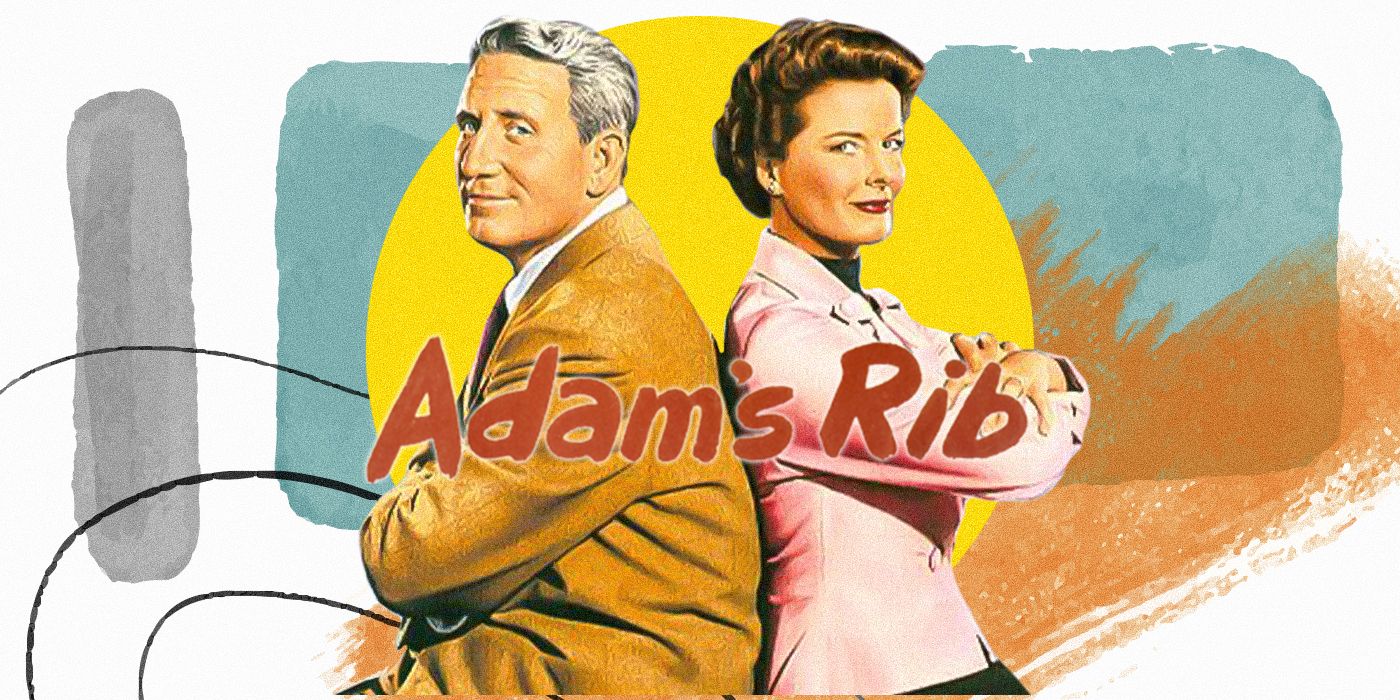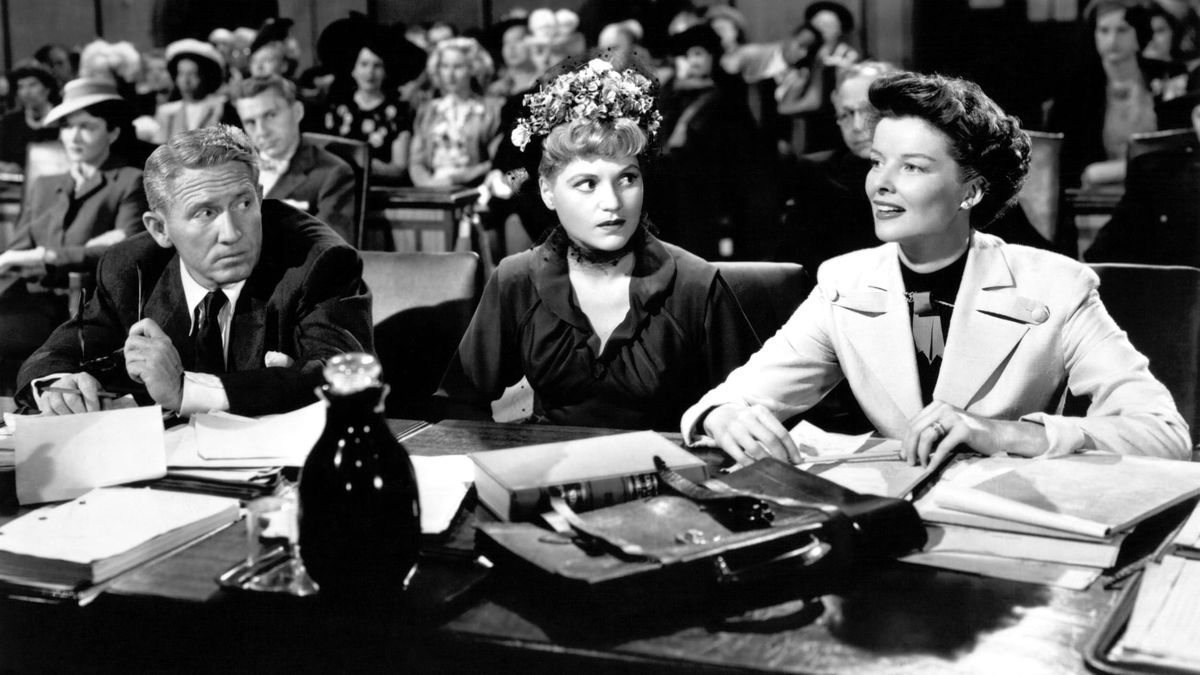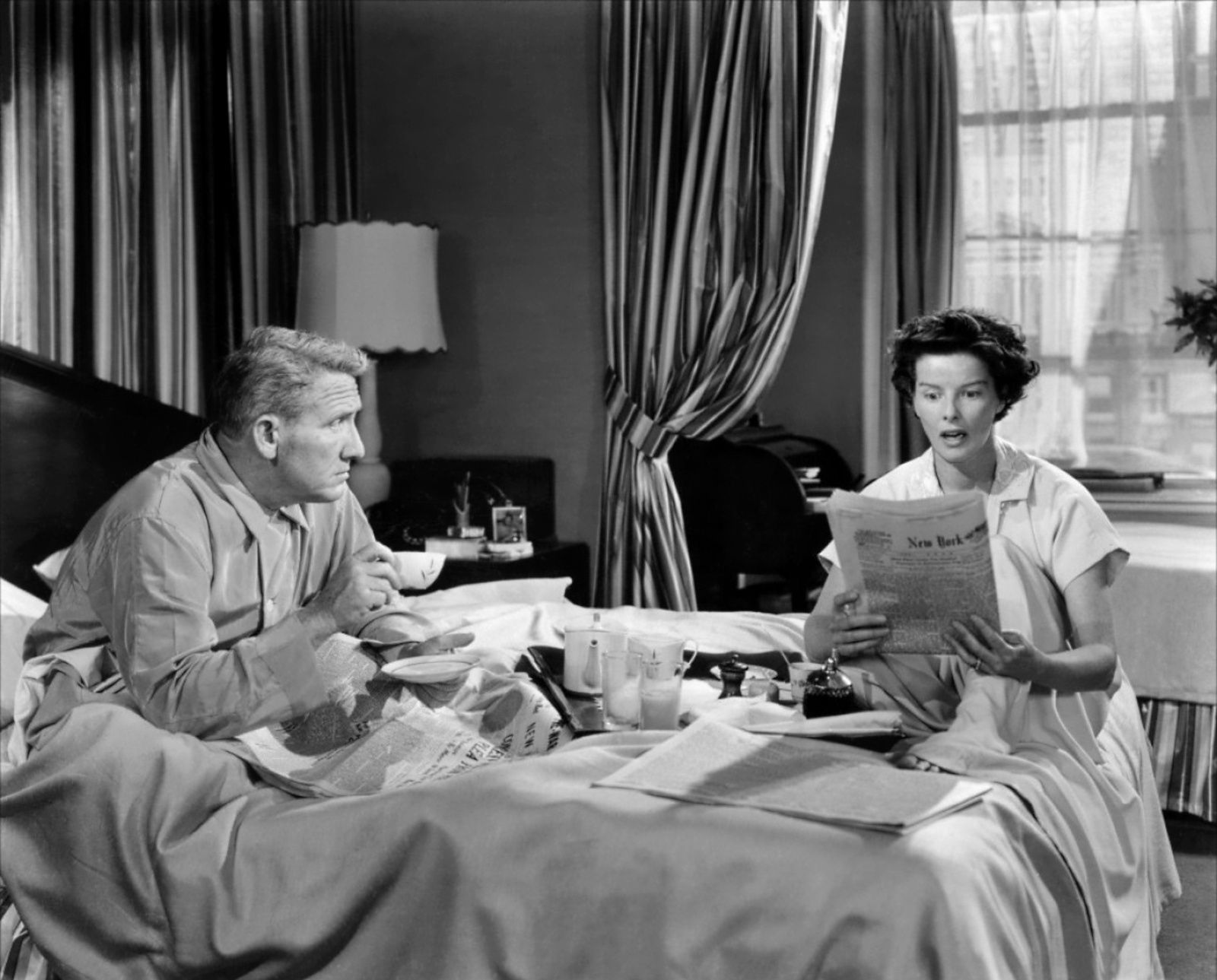There are few romantic screen pairings as prolific or beloved in their heyday as Katherine Hepburn and Spencer Tracy. That said, their reputation has suffered a bit from the fact that there isn’t an unimpeachably classic movie in their repertoire that casual film fans would be familiar with, possibly with the exception of the Oscar-winning Guess Who’s Coming To Dinner? This is a bit surprising, considering Guess Who’s Coming To Dinner? serves as a fitting conclusion to a number of films Hepburn and Tracy starred in that took on social issues that were relevant at the time of their release and (for better or worse) remain relevant today. And because Hepburn and Tracy had such a knack for comedy and banter in addition to their desire to take on hot-button topics, even their most thought-provoking movies are still very light and enjoyable without ever feeling heavy-handed. There’s perhaps no better example of this than Adam’s Rib, a movie that tackles women’s equality with this witty and assured approach, and was released smack dab in the middle of Hepburn and Tracy’s run of films together.
The first of Katherine Hepburn and Spencer Tracy’s films together was 1942’s Woman of the Year, which also happened to be the first time that either of them had met. The story goes that one of Hepburn’s first remarks to Tracy on-set was “I fear I may be too tall for you, Mr. Tracy”, to which Tracy replied something of the effect “Don't worry, I'll cut you down to my size.” Clearly whatever height-based differences they had were soon washed away, as the two of them would quickly start a romantic relationship that lasted until Tracy’s death in 1967 (they never married because Tracy wouldn’t divorce his first wife since he was a devout Catholic). They had already established a tendency to challenge the societal norms of the 1940s in Woman of the Year, which focuses on two reporters and how the career-driven Hepburn must adapt to the then-expectations of also being a successful housewife. While the film gets at some interesting themes about mid-20th-century womanhood that were rarely explored in Hollywood films (it’s one of the earliest movies I can think of that uses the word “feminism”), its final act wraps up a little too nicely to follow through on answering the complicated questions it asks. However, it laid the groundwork for Adam’s Rib to ask these questions in an even more pointed manner.
One likely reason that Adam’s Rib tackles the double standards women face more effectively than Woman of the Year (and most classic movies in general) is that it was co-written by a woman. Ruth Gordon (most famous for playing Maude in 1971’s Harold and Maude) wrote the film with her husband, Garson Kanin, who was also a close friend of Hepburn’s and must have known to some degree the inner workings of her and Tracy’s off-screen relationship. Also, adding one other degree to the real-life parallels in the film is the fact that Gordon and Kanin based their screenplay on the true story of two lawyers they knew who were married, but then divorced and ended up with two of their own respective clients. While Adam’s Rib sidesteps the story possibilities of this particular conflict of interest, they nonetheless decided to take advantage of the idea of two married lawyers by having them go up against each other in court.
In the movie, Hepburn is defense attorney Amanda Bonner, whose client Doris Attinger (Judy Holliday in a break-out role) is accused of attempted murder. She tried to shoot her husband (Tom Ewell) in a fit of rage (but didn’t kill him), which leads Amanda to argue that the sentence leveled at Doris for a crime of passion would be unjustly more strict for a woman than a man. Tracy plays Adam Bonner, an assistant district attorney who is assigned by his office to prosecute the same case (somewhat against his wishes). Though he sees Amanda’s point that women should be treated equally as men, he maintains that “the law is the law” and so feels justified in taking on Amanda in court. Though he clearly doesn’t have the same passion that Amanda has for the case, the way he’s often emasculated in his own home causes him to become more and more invested.
From the film’s opening sequence, Adam’s Rib makes it apparent that it is going to walk a fine line between hard-hitting drama and comedic irreverence. We see the accused murderer Doris slowly heading up to her apartment where she’s about to catch her husband Warren cheating on her, though as she takes a gun out of her purse, she consults an instructional booklet on how to properly use a firearm. It sets the tone nicely for the rest of the film, as the movie will often let Hepburn grandstand about why women deserve to be treated equally in the eyes of the law as men. Though then just moments later, the movie will counter this with some visual gag like Tracy being foisted into the air by a female circus performer or him and Hepburn coyly making hand signals or faces at each other under the tables in court. You could make the case that the film’s mix of comedy and women’s equality maybe doesn’t give the issue the seriousness it deserves, but you have to imagine that it was more persuasive in making audiences at the time reconsider women’s places in society through charming laughs instead of beating them over the head with it.
Another element that makes the film feel ahead of its time is how natural the verbal sparring between Hepburn and Tracy is. Though Hepburn was known to rattle off mile-a-minute dialogue in the screwball comedies she did throughout the ‘30s and ‘40s, the banter here is a little different. Though there are plenty of clever asides, the way Hepburn and Tracy trade words feels a little more loose and conversational. Many of their conversations take place in their lavish New York apartment at night, either while preparing for their big case or the night of one of the trial dates. These conversations can’t help but feel like an extension of the way Tracy and Hepburn talked to each other at home, which feels even more the case when the film’s writers were keenly aware of how they talked to each other when they weren’t making movies. Alternately, the scenes in court are the complete opposite, where Hepburn is all performance, feeling it’s her duty to passionately impose her own ideals on the jury, while Tracy struggles to keep up. It’s easy to look at this juxtaposition of how they act at home and how they act in court as a kind of commentary on how the real-life Hepburn and Tracy acted at home as opposed to in their movies.
A huge part of juggling all these disparate elements is the steady hand of director George Cukor. At this point in his career, Cukor was one of the most consistent and respected directors in Hollywood, while also being uniquely great at making films about women. Additionally, he had already made six films with Katharine Hepburn, a crucial and long-lasting professional partnership that resulted in other triumphs like 1940's The Philadelphia Story and the 1933 adaptation of Little Women. Cukor had also previously worked with Hepburn and Tracy together on Keeper of the Flame, which caused controversy at the time for its leftist politics in addition to mixed reviews. It’s possible that this earlier bungled attempt at a “message movie” informed the sly way that Cukor is able to grapple with Adam’s Rib’s feminist issues in a way that doesn’t shy away from the material, but also was able to get past the studio heads without causing a stir. In addition to getting the most out of Hepburn and Tracy in the movie (as well as some great supporting performances from Holliday and Ewell), one thing that stands out about the movie's style is its use of long, uninterrupted takes. It feels less like Cukor is doing this to show off than to place more emphasis on the performances and the writing, which feels very reflective of Cukor’s generous approach to filmmaking.
There are a lot of things that hold up surprisingly well about Adam’s Rib, most notably the representation of a female lawyer as something perfectly normal in a time when it was a rarity. That said, the court case revolves around “crimes of passion” laws, which were a lot more applicable to the ironclad fidelity that was expected of married couples at the time. Also, some of the movie’s views on the differences (or lack thereof) between men and women feels a little overly simplistic by today’s standards. Obviously, that’s going to be the case with any movie from 70 years ago, and the fact that Adam’s Rib feels both so true to the gender dynamics of its time and still resonates today is wonderful to witness. Then the fact that it’s just as enjoyable as a courtroom comedy as it is as a film capable of changing minds, much like Hepburn and Tracy, makes for a winning combination.



